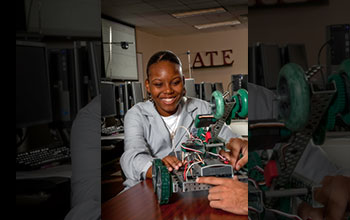Multimedia Gallery
Student terminating connections for a VEX robot project
A mechanical engineering technology student terminates connections for a VEX robot project prior to program testing as part of the Teaching Technicians program sponsored by the South Carolina Advanced Technological Education Center (SC ATE), a U.S. National Science Foundation Advanced Technological Education center.
More about this image
The VEX Robotics Design System offers students an exciting platform for learning about science, technology, engineering and mathematics, only a few of the many fields students can explore by creating with VEX Robotics technology. Beyond science and engineering principles, a VEX Robotics project encourages teamwork, leadership and problem-solving among groups, and allows educators to easily customize projects to meet the level of students' abilities. The affordable VEX platform is expanding rapidly and is now found in middle schools, high schools and university labs around the globe. Robotics hobbyists also appreciate the advanced capabilities of the VEX system.
Located at Florence-Darlingtion Technical College in Florence, South Carolina, the center is dedicated to expanding excellence in technician education and increasing the quantity, quality and diversity of engineering technology graduates to support business and industry, and to encourage continued economic development.
To learn more about SC ATE, visit the center's website Here.
About NSF's ATE Program
With an emphasis on two-year colleges, NSF's ATE program focuses on the education of technicians for the high-tech fields that drive our nation's economy. ATE involves partnerships between academic institutions and employers to promote improvement in the education of science and engineering technicians at the undergraduate and secondary school levels. ATE supports curriculum development; professional development of college faculty and secondary school teachers; career pathways to two-year colleges from secondary schools and from two-year colleges to four-year institutions; and other activities. Another goal is articulation between two-year and four-year programs for K-12 prospective teachers that focus on technological education. The program also invites proposals focusing on research to advance the knowledge base related to technician education.
This image appeared in the ATE Centers Impact 2011 report, which was prepared by the ATE centers with support from NSF grant DUE 1040932, awarded to the Academic and Student Affairs Division of the Maricopa Community Colleges. The full report can be viewed Here. (Date of Image: 2010-11)
Credit: Photo from ATE Centers Impact 2011 (www.atecenters.org)
Images and other media in the National Science Foundation Multimedia Gallery are available for use in print and electronic material by NSF employees, members of the media, university staff, teachers and the general public. All media in the gallery are intended for personal, educational and nonprofit/non-commercial use only.
Images credited to the National Science Foundation, a federal agency, are in the public domain. The images were created by employees of the United States Government as part of their official duties or prepared by contractors as "works for hire" for NSF. You may freely use NSF-credited images and, at your discretion, credit NSF with a "Courtesy: National Science Foundation" notation.
Additional information about general usage can be found in Conditions.
Also Available:
Download the high-resolution JPG version of the image. (10.2 MB)
Use your mouse to right-click (Mac users may need to Ctrl-click) the link above and choose the option that will save the file or target to your computer.

 All images in this series
All images in this series